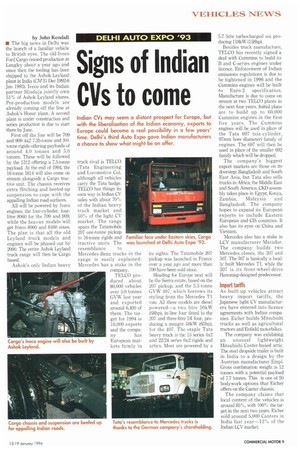Signs of Indian CVs to come
Page 11

If you've noticed an error in this article please click here to report it so we can fix it.
by John Kendall
• The big news in Delhi was the launch of a familiar vehicle to British eyes. The old Iveco Ford Cargo ceased production at Langley about a year ago and since then the tooling has been shipped to the Ashok Leyland plant in India (CM 31 Dec 1992-6 Jan 1993). Iveco and its Indian partner Hinduja jointly own 51% of Ashok Leyland shares. Pre-production models are already coming off the line at Ashok's Hosur plant. A second plant is under construction and series production is due to start there by June.
First off the line will be 709 and 909 4x2 7.35-tonne and 9.0tonne rigids offering payloads of around 4.0 tonnes and 5.0 tonnes. These will be followed by the 1312 offering a 7.5-tonne payload. At the end of 1994, the 16-tonne 1614 will also come on stream alongside a Cargo tractive unit. The chassis receives extra flitching and beefed-up suspension to cope with the appalling Indian road surfaces.
All will be powered by Iveco engines; the four-cylinder, fourlitre 8060 for the 709 and 909, while the heavier models will get Iveco 8060 and 8460 sixes. The plan is that all the old Leyland truck models and engines will be phased out by 2000. The entire Ashok Leyland truck range will then be Cargo based_ Ashok's only Indian heavy
truck rival is TELCO (Tata Engineering and Locomotive Co), although all vehicles carry the Tata badge. TELCO has things its own way in Indian CV sales with about 70% of the Indian heavy truck market and 50% of the light CV market. The range spans the Tatamobile 207 one-tonne pickup to 16-tonne rigids and tractive units. The
resemblance to Mercedes-Benz trucks in the range is easily explained: Mercedes has a stake in the company.
TELCO produced about 80,000 vehicles over 5.0 tonnes GVW last year and exported around 6,400 of them. The target for 1994 is 10,000 exports and the compa ny has European markets firmly in its sights. The Tatamobile 207 pickup was launched in France over a year ago and more than 700 have been sold since.
Heading for Europe next will be the Sierra estate, based on the 207 pickup, and the 5.3-tonne GVW 407, which borrows its styling from the Mercedes T1 van. All these models are diesel powered—a two litre 50kW (68hp), in-line four fitted to the 207 and three-litre DI four, producing a meagre 48kW (65hp), for the 407. The staple Tata heavy truck is the 15 series 4x2 and 22/24 series 6x2 rigids and artics. Most are powered by a 5.7 litre turbocharged six producing 118kW (158hp).
Besides truck manufacture, TELCO has recently signed a deal with Cummins to build its B and C-series engines under licence. Enforcement of Indian emissions regulations is due to be tightened in 1996 and the Cummins engines will be built to Euro-2 specification. Manufacture is due to come on stream at two TELCO plants in the next four years. Initial plans are to build up to 60,000 Cummins engines in the first five years. The Cummins engines will be used in place of the Tata 697 (six-cylinder, 97mm bore diameter) family of engines. The 697 will then be used in place of the smaller 692 family which will be dropped.
The company's biggest export markets are those on its doorstep: Bangladesh and South East Asia, but Tata also sells trucks in Africa, the Middle East and South America. CKD assembly takes place in Egypt, Kenya, Zambia, Malaysia and Bangladesh. The company hopes to expand its European exports to include Eastern European and CIS countries. It also has its eyes on China and Vietnam.
Mercedes also has a stake in LCV manufacturer Matador. The company builds two Mercedes clones, the 307 and 507. The 507 is basically a locally built Mercedes Ti, while the 307 is its front-wheel-drive Hanomag-designed predecessor.
Import tariffs
As built-up vehicles attract heavy import tariffs, the Japanese light CV manufacturers have entered into licence agreements with Indian companies. Eicher builds Mitsubishi trucks as well as agricultural tractors and Enfield motorbikes.
The company was exhibiting an unusual lightweight Mitsubishi Canter-based artic. The steel dropside trailer is built in India to a design by the Austrian manufacturer Empl. Gross combination weight is 12 tonnes with a potential payload of 7.7 tonnes. This is one of 50 bodywork options that Eicher offers on the Canter chassis.
The company claims that local content of the vehicles is around 85%, with 100% the target in the next two years. Eicher sold around 5,000 Canters in India last year 12% of the Indian LCV market.
















































































